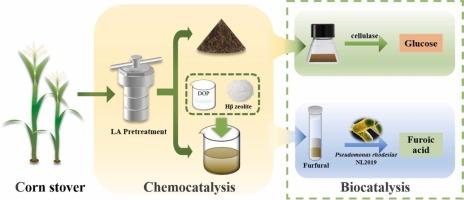串联化学催化和生物催化协同促进玉米秸秆糠酸和葡萄糖的生产
IF 6.2
1区 农林科学
Q1 AGRICULTURAL ENGINEERING
引用次数: 0
摘要
从生物质中提取生物基化合物的合成对促进可持续发展和环境保护至关重要。本研究以玉米秸秆为原料,采用化学催化与生物催化相结合的方法制备糠酸和葡萄糖。采用2 wt%的乳酸(LA)对玉米秸秆进行预处理,木糖和低聚木糖(XOS)的总收率最高,达到86.1% %。水解产物在双相体系中以0.25 % Hβ沸石和事先存在的LA催化得到糠醛,在相同的双相体系中以70.5 %的产率在罗得西亚假单胞菌的生物催化剂上进一步转化为FA。此外,还对相关催化反应的可能机理进行了探讨,固体残渣的酶解糖化效率达到87.5 %,比原玉米秸秆提高了3.3倍。更重要的是,获得的葡萄糖可以作为细胞培养的底物,促进生物催化剂(P. rhodesiae)和化学催化剂(乳酸)的生产。这种简便的联合生产FA和葡萄糖的生物精炼方法以更环保、更简单的方式提高了玉米秸秆的生物利用度,避免了强酸和复杂的化学催化剂。本文章由计算机程序翻译,如有差异,请以英文原文为准。

Synergistic boosting furoic acid and glucose production from corn stover by tandem chemocatalysis and biocatalysis
The synthesis of bio-based compounds derived from biomass is essential for promoting sustainable development and environmental preservation. In this study, a tandem chemocatalysis and biocatalysis approach was proposed to co-produce furoic acid (FA) and glucose from corn stover. The corn stover was pretreated using 2 wt% lactic acid (LA), achieving the highest xylose and xylooligosaccharides (XOS) overall yield of 86.1 %. The hydrolysate was catalyzed in a biphasic system by 0.25 % Hβ zeolite and pre-existing LA to obtain furfural, which was further converted into FA at 70.5 % yield in the same biphasic system using biocatalyst of Pseudomonas rhodesiae. In addition, the possible mechanisms of the associated catalytic reactions were also discussed and the enzymatic saccharification efficiency of the solid remains was enhanced to 87.5 %, increased by 3.3 times than that of the original corn stover. More importantly, the glucose obtained could serve as a substrate for cell cultivation, facilitating the production of both biocatalyst (P. rhodesiae) and chemical catalyst (lactic acid). This facile biorefinery method of co-production of FA and glucose improves the bioavailability of corn stover in a greener and simpler manner, avoiding strong acids and complex chemical catalysts.
求助全文
通过发布文献求助,成功后即可免费获取论文全文。
去求助
来源期刊

Industrial Crops and Products
农林科学-农业工程
CiteScore
9.50
自引率
8.50%
发文量
1518
审稿时长
43 days
期刊介绍:
Industrial Crops and Products is an International Journal publishing academic and industrial research on industrial (defined as non-food/non-feed) crops and products. Papers concern both crop-oriented and bio-based materials from crops-oriented research, and should be of interest to an international audience, hypothesis driven, and where comparisons are made statistics performed.
 求助内容:
求助内容: 应助结果提醒方式:
应助结果提醒方式:


